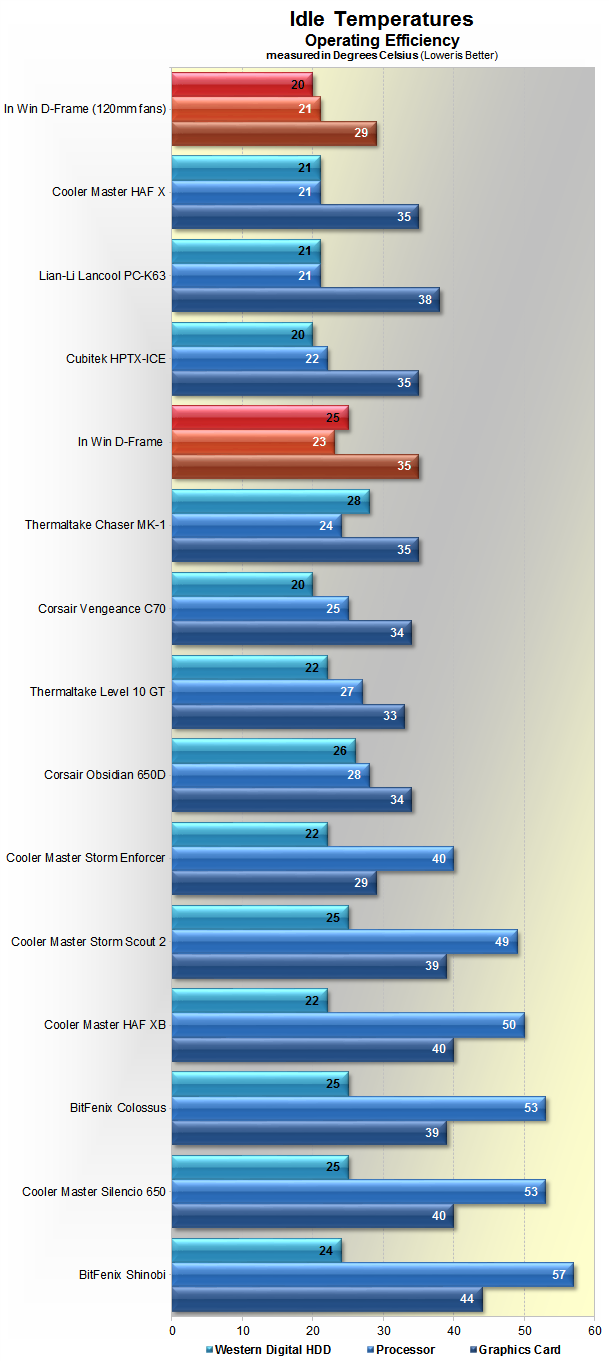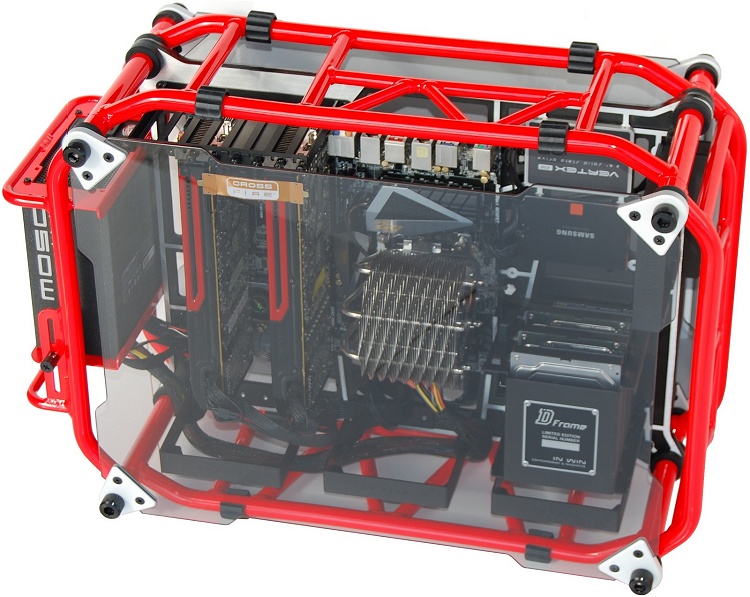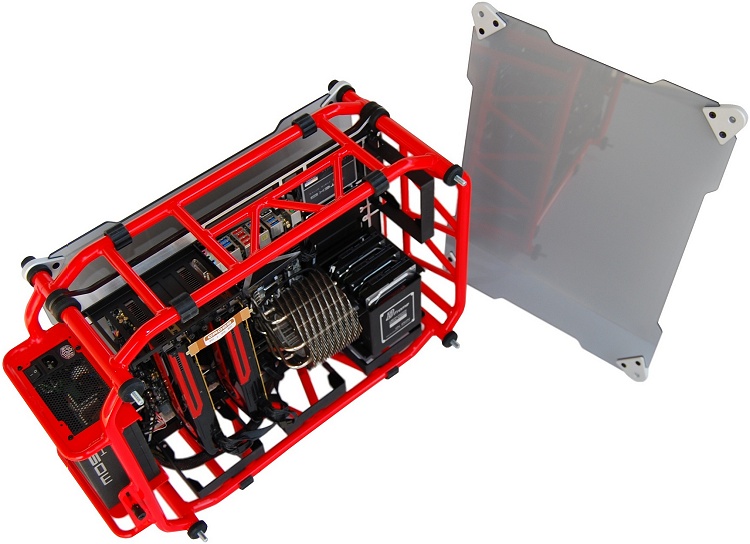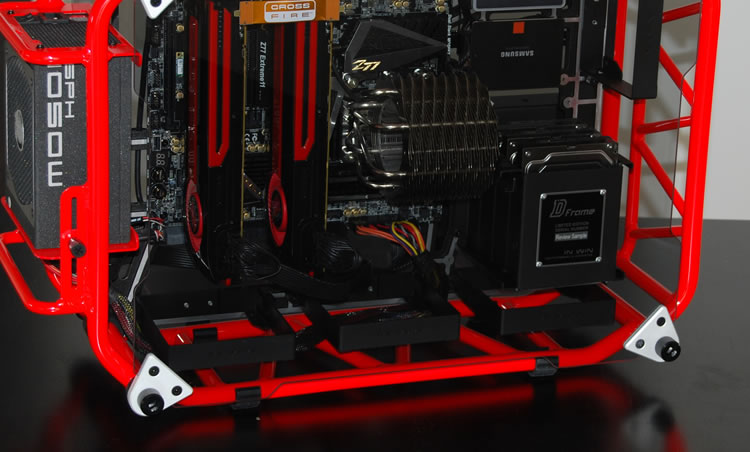Performance & Final Thoughts
To ensure accurate thermal results, we installed the same hardware in each case in virtually the same way. Components included the Asrock Fatal1ty 990FX Professional, Phenom II X6 1100T, Prolimatech Megahalems (we took the case door off) in passive mode (i.e. no fan actively dispelling heat), Inno3D GeForce GTX 580 OC, half a dozen Western Digital Scorpio Blue 500GB hard drives, and OCZ's ZX 1000w power supply.
We tested the D-Frame in two different configurations. The one labeled "In Win D-Frame (120mm fans)" has the four optional 120mm (Silverstone AP121) installed leaving the Prolimatech Megahalems in passive mode, while the other is simply labeled "In Win D-Frame" and has a 120mm fan on the Megahalems heatsink but no case fans.
All testing was conducted with an ambient room temperature of 19 to 21 degrees Celsius (66 to 69 Fahrenheit).

The D-Frame performed exceptionally well when fitted with four Silverstone AP121 fans, keeping the Western Digital hard drive at just 20 degrees or roughly room temperature. The CPU also idled at around room temperature while the graphics card ran a little hotter at 29 degrees. These are some of the best results we have seen.
Removing all the 120mm case fans and installing a fan on the Prolimatech Megahalems resulted in considerably higher idle temperatures for the hard drive and graphics card while the CPU temperature only increased two degrees.

The D-Frame remained quite cool when dealing with the CPU and GPU at full load. With the 120mm chassis fans installed, hard drive temperatures remained at just 20 degrees and that figure jumped to 26 degrees with only the heatsink fan present.
The CPU temperature was lowest when placing a 120mm fan directly over the heatsink and that isn't particularly surprising. Nonetheless, the CPU temperature only increased to 73 degrees while its heatsink was passively cooled.
Final Thoughts
We'll come right out and say it: we generally dislike open-air computer cases. Enclosures such as the Antec LanBoy Air are serious dust magnets and are often louder than traditional solutions. The D-Frame exacerbates those shortcomings by lacking features such as stock fans and an external storage bay, but we appreciate the additional cooling capabilities, ease of installation and general showiness of its open-air design, which is the best we've seen and fun enough to work with that we could accept its drawbacks.

Along with clean welds and a durable paint job, the D-Frame comes with two high quality tempered glass side panels that help justify its $400 asking price. In Win's attention to detail is excellent all around, having included all black sleeved cables as well as the tools required to build the case. The enclosure's cable management setup is first class, providing practical means of routing excess wires, while there is plenty of clearance for components such as the power supply and multiple high-end graphics cards.
In case you skipped the earlier pages, we should note again that the D-Frame must be assembled itself before you can install PC hardware and some may view this as a negative while plenty of others will love it. Although we enjoy playing enthusiast as much as the next hardware buff, there's really no reason why the case couldn't come prebuilt and at the very least In Win could improve the assembly instructions. Nonetheless, we managed fine with the company's directions and we assume most others would too.

The bottom line is that we absolutely love the D-Frame and wouldn't hesitate to buy it tomorrow – if not for its price, which at least makes me think twice about the competition at the same price range. Anything as unique as the D-Frame tends to carry some kind of premium and that's precisely the situation here. At $400, In Win is offering one of the most expensive cases available, out-pricing the Lian Li PC-V2120, Silverstone Temjin TJ07, Cooler Master Cosmos II and even the Corsair 900D. The D-Frame is $20 to $50 more than those cases while being smaller and having less features.
The choice won't be easy for the average gamer to part with this kind of cash when there are many fine choices in the sub-$200 territory, however the D-Frame is definitely the most unique product among those mentioned and quite possibly the most appealing for those building a hardcore gaming machine when you consider its respectable cooling performance. If you know how to wield a can of compressed air, the D-Frame could be the perfect chassis for your next luxury system.
Pros: Unique looks set the D-Frame apart. Open-air design performed exceptionally well. DIY'ers will love the fact you must assemble it first.
Cons: Relatively feature-less case when compared to the competition. Steep price to ask for a PC case.
